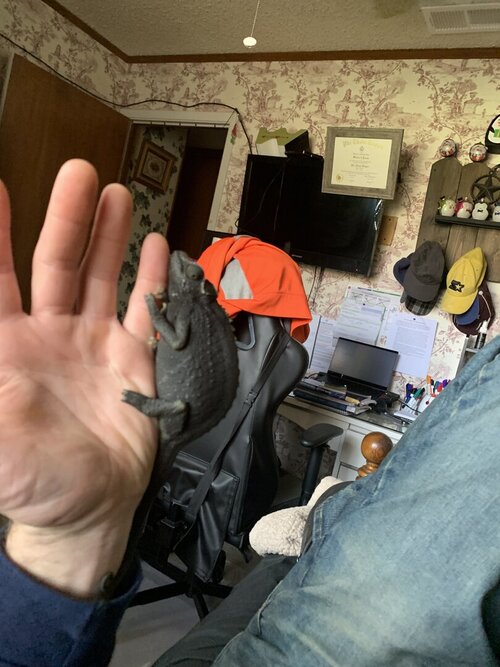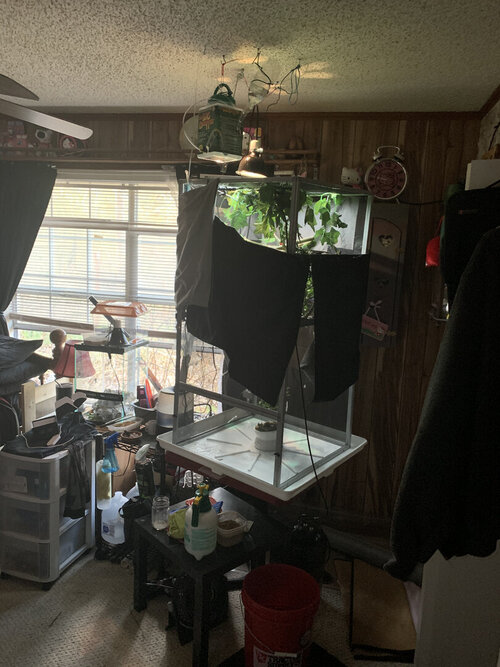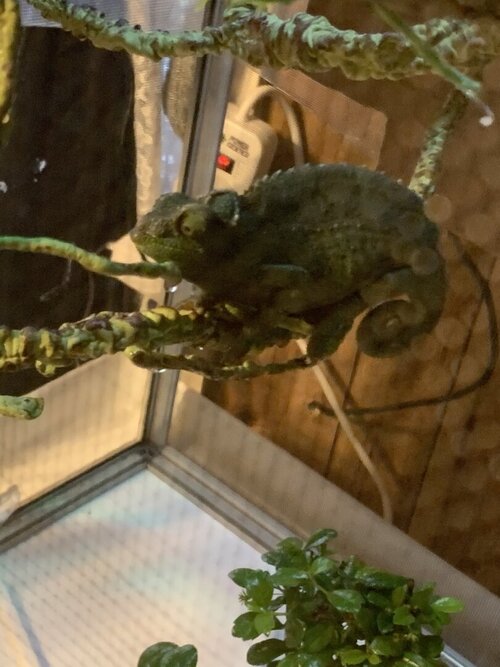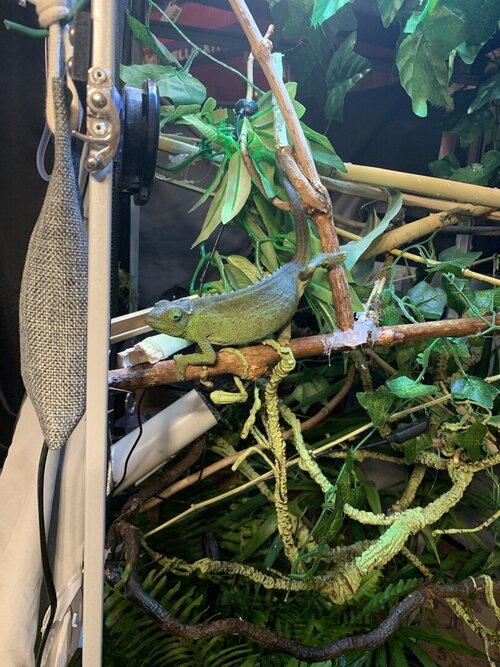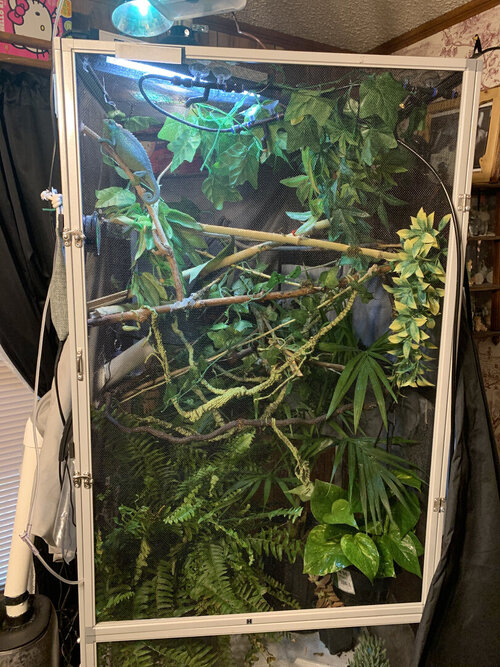Navigation
Install the app
How to install the app on iOS
Follow along with the video below to see how to install our site as a web app on your home screen.
Note: This feature may not be available in some browsers.
More options
You are using an out of date browser. It may not display this or other websites correctly.
You should upgrade or use an alternative browser.
You should upgrade or use an alternative browser.
Turning black
- Thread starter wprazak
- Start date
Mendez
Chameleon Enthusiast
What are your room conditions? My suggestion is to put her back in her cage and leave her alone with proper temps. Make sure the ambient temps are between 70-75 and basking is right around 80 flat. You live in Texas, right? Were you able to keep her warm during the freezes? They can turn jet black when too cold. Is she still this color? If she is still on your hand, put her on a branch that is close to (but not directly under) the basking spot. See if she lightens up.
Once you answer these questions, be sure to fill out the form I post below. This can also help us narrow down why this is happening. Be sure to submit the above questions as soon as possible.
@JacksJill @Kaizen have you seen this before with a Jacksons? Seems too dark for trying to warm up unless insanely cold. Could this be something else? I personally haven't experienced colors like this.
@kinyonga @Beman @MissSkittles have you seen anything like this before?
Once you answer these questions, be sure to fill out the form I post below. This can also help us narrow down why this is happening. Be sure to submit the above questions as soon as possible.
@JacksJill @Kaizen have you seen this before with a Jacksons? Seems too dark for trying to warm up unless insanely cold. Could this be something else? I personally haven't experienced colors like this.
@kinyonga @Beman @MissSkittles have you seen anything like this before?
Mendez
Chameleon Enthusiast
Fill out this form after you submit the answers to the above questions.
Chameleon Info:
Cage Info:
Current Problem - Not necessary, OP already stated in the post.
--------------
Please Note:
Chameleon Info:
- Your Chameleon - The species, sex, and age of your chameleon. How long has it been in your care?
- Handling - How often do you handle your chameleon?
- Feeding - What are you feeding your cham? What amount? What is the schedule? How are you gut-loading your feeders?
- Supplements - What brand and type of calcium and vitamin products are you dusting your feeders with and what is the schedule?
- Watering - What kind of watering technique do you use? How often and how long to you mist? Do you see your chameleon drinking?
- Fecal Description - Briefly note colors and consistency from recent droppings. Has this chameleon ever been tested for parasites?
- History - Any previous information about your cham that might be useful to others when trying to help you.
Cage Info:
- Cage Type - Describe your cage (Glass, Screen, Combo?) What are the dimensions?
- Lighting - What brand, model, and types of lighting are you using? What is your daily lighting schedule?
- Temperature - What temp range have you created (cage floor to basking spot)? Lowest overnight temp? How do you measure these temps?
- Humidity - What are your humidity levels? How are you creating and maintaining these levels? What do you use to measure humidity?
- Plants - Are you using live plants? If so, what kind?
- Placement - Where is your cage located? Is it near any fans, air vents, or high traffic areas? At what height is the top of the cage relative to your room floor?
- Location - Where are you geographically located?
Current Problem - Not necessary, OP already stated in the post.
--------------
Please Note:
- The more details you provide the better and more accurate help you will receive.
- Photos can be very helpful.
wprazak
Member
She was fine until today. I never watch tv in my room but I did today. I turned it off placed her in her house. Removed all crickets and super worms. Removed the succulents and put her curtains up where I can’t see her and she can’t see me. She is moving around but still a dark color. She normally likes to be held. When she sees me she comes to the door and I normally get her and walk around and she just sits and chills in my shoulder. I didn’t today other than when she freaked me out by freezing up.What are your room conditions? My suggestion is to put her back in her cage and leave her alone with proper temps. Make sure the ambient temps are between 70-75 and basking is right around 80 flat. You live in Texas, right? Were you able to keep her warm during the freezes? They can turn jet black when too cold. Is she still this color? If she is still on your hand, put her on a branch that is close to (but not directly under) the basking spot. See if she lightens up.
Once you answer these questions, be sure to fill out the form I post below. This can also help us narrow down why this is happening. Be sure to submit the above questions as soon as possible.
@JacksJill @Kaizen have you seen this before with a Jacksons? Seems too dark for trying to warm up unless insanely cold. Could this be something else? I personally haven't experienced colors like this.
@kinyonga @Beman @MissSkittles have you seen anything like this before?
Mendez
Chameleon Enthusiast
It could be that the tv stressed her out, though highly unlikely to be the cause of why she is jet black.She was fine until today. I never watch tv in my room but I did today. I turned it off placed her in her house.
Do you normally keep the succulents in her cage?Removed all crickets and super worms. Removed the succulents and put her curtains up where I can’t see her and she can’t see me.
This behavior is not normal. When she wants to come out of her cage, it means that something is not right inside the cage. One of your husbandry parameters is likely off. Make sure to include what equipment you use to measure humidity and temps. Don't be afraid to say that you don't know something. We are more than happy to help you out.She is moving around but still a dark color. She normally likes to be held. When she sees me she comes to the door and I normally get her and walk around and she just sits and chills in my shoulder. I didn’t today other than when she freaked me out by freezing up.
I do want to mention that they can get curious and decide to wander outside of their cage on their own free will--but not very frequently. It's also a possibility that someone can develop a relationship where the cham recognizes when it is "outdoor time"--but these behaviors should still not be correlated with a relationship as it is very possible that the owner thinks that the cham knows it is outdoor time when in fact the parameters are wrong and is trying to escape.
CasqueAbove
Chameleon Enthusiast
I don't know Jacksons, but when I have seen that it is in response to fear. big fear. It could be something else for sure, so keep an eye out.
But for my 2 cents something scared the s*** out of her. I have seen it with babies when a male got on their cage. Some stayed black and buried in the leaf liter for over a day. Great survival strategy. When all else fails turn dark, hide in the leaf liter and hope for the best. They were almost impossible to find.
If she doesn't come back to normal rather quick, under 24 hours I would dig deeper.
But for my 2 cents something scared the s*** out of her. I have seen it with babies when a male got on their cage. Some stayed black and buried in the leaf liter for over a day. Great survival strategy. When all else fails turn dark, hide in the leaf liter and hope for the best. They were almost impossible to find.
If she doesn't come back to normal rather quick, under 24 hours I would dig deeper.
wprazak
Member
Chameleon Info:
Cage Info:
- Your Chameleon - The species, sex, and age of your chameleon. How long has it been in your care?
- Handling - How often do you handle your chameleon?
- Feeding - What are you feeding your cham? What amount? What is the schedule? How are you gut-loading your feeders?
- Supplements - What brand and type of calcium and vitamin products are you dusting your feeders with and what is the schedule?
- Watering - What kind of watering technique do you use? How often and how long to you mist? Do you see your chameleon drinking?
- Fecal Description - Briefly note colors and consistency from recent droppings. Has this chameleon ever been tested for parasites?
- History - Any previous information about your cham that might be useful to others when trying to help you.
Cage Info:
- Cage Type - Describe your cage (Glass, Screen, Combo?) What are the dimensions?
- Lighting - What brand, model, and types of lighting are you using? What is your daily lighting schedule?
- Temperature - What temp range have you created (cage floor to basking spot)? Lowest overnight temp? How do you measure these temps?
- Humidity - What are your humidity levels? How are you creating and maintaining these levels? What do you use to measure humidity?
- Plants - Are you using live plants? If so, what kind?
- Placement - Where is your cage located? Is it near any fans, air vents, or high traffic areas? At what height is the top of the cage relative to your room floor?
- Location - Where are you geographically located? East Texas
This schedule alone is enough to kill her. She should only have the Repashy LoD twice a month and no other supplements with D3 or vitamins at all. She should be getting calcium WITHOUT D3 twice a week.Flukers ReptaCalcium with D3, Repashy Calcium plus LoD, Calcium Spray, and a liquid multivitamin. Twice a week with Repashy, once a month the Flukers Reptacalcium, daily with the calcium spray, and every other day the multivitamin
- Supplements - What brand and type of calcium and vitamin products are you dusting your feeders with and what is the schedule?
I can't go over the rest right now but this is a big red flag. I have never seen one go that black on both sides. I would back off from handling her for quite a while and fix her supplement schedule immediately. I wouldn't give any more D3 this month. It takes two months to get out of their system.
Mendez
Chameleon Enthusiast
Unless you need to handle her, give her a break. Most likely it looks like she wants to be handled because something is off in her cage. Let's focus on fixing that problem first, before possibly introducing stressful situations. I'm not saying that you are stressful to her, but I want to make sure everything is perfect first, and to do this, we need to remove any possible confounding variables.Handle once a day sometimes once every other day
- Handling - How often do you handle your chameleon?
Superworms can be addicting. I wouldn't remove them from her diet, but I would probably reduce the frequency. How many days a week do you feed her?Crickets, Superworms, and Dubai roaches she likes to eat the superworms more than crickets and roaches. Gut-loaded with fresh collard greens, cucumbers, carrots, spinach, zucchini, nectarines, cricket quencher and calcium fortified cricket quencher
- Feeding - What are you feeding your cham? What amount? What is the schedule? How are you gut-loading your feeders?
Toss out the Flukers ReptaCalcium and the liquid multivitamin, and reduce the Repashy Calcium plus LoD to only twice a month. You will need to get a plain calcium supplement that does not have D3 or Multivitamins. The rate that you are supplementing her--it will most likely, if not already, lead to signs of overdose. This could be edema or something that looks very similar to MBD. Too much d3 supplementation is like an inverted parabola--too much or too little will lead to the same/similar negative results.Flukers ReptaCalcium with D3, Repashy Calcium plus LoD, Calcium Spray, and a liquid multivitamin. Twice a week with Repashy, once a month the Flukers Reptacalcium, daily with the calcium spray, and every other day the multivitamin
- Supplements - What brand and type of calcium and vitamin products are you dusting your feeders with and what is the schedule?
Your future supplementation schedule:
--Repashy calcium plus lod twice a month (this has both D3 and multivitamin)
--A plain calcium such as Arcadia Earthpro-Ca or really anything that is comprised of only calcium carbonate. (Check the ingredient list on the bottle)
Part 2 in a few minutes
Mendez
Chameleon Enthusiast
If your humidity levels are correct (30-40% during the day and 75-100% at night) and you provide a lot of foliage to catch run-off water, then your cham will have ample opportunities to drink. By the looks of your cage, you need to add more live plants--especially near the bottom. You want to use up every part of the cage--not just the top.I hand mist, when I’m in classes I have a mister set on timer twice in an 8 hours period, so once for 2 minutes every 4 hours, also a dripper and an IV line with a slow drip. She drinks for me when I Place the IV hose to her mouth with a slow drip, I’m worried she isn’t drinking enough
- Watering - What kind of watering technique do you use? How often and how long to you mist? Do you see your chameleon drinking?
Sounds like she is getting enough to drink. I would refrain from holding the dripper to her mouth. She will get the water she needs. Just make sure your humidity is high at night and provide a spot where the dripper drips onto a few leaves. If you have that, she will drink on her own.No parasite testing, fecal matter is white urate and a brown turd. Not very mucous like but more thick texture.
- Fecal Description - Briefly note colors and consistency from recent droppings. Has this chameleon ever been tested for parasites?
You do not need two uvb bulbs. Hopefully @Beman can help you with the distance of a arcadia 7% from the basking spot. If you are setting the 12% on top of the cage directly, it is possible that she is getting exposed to crazy amounts of uvb. Are you seeing her bask? If the high levels of uvb keeps her from visiting the top of the cage, she may not be getting warm enough to synthesize the high levels of D3 currently in her body which can be deadly.Cage Info:
ReptiZoo T8 hood with Arcadia 12% D3 , an arcadia shadedweller 7%, the heat lamps are a mini halogen 25w and a ZooMed DayLight 50w incandescent
- Lighting - What brand, model, and types of lighting are you using? What is your daily lighting schedule?
Bump up the basking spot temps to around 78-80 if possible. Since you have high fluctuations in basking temps, you may want to look into stabilizing temps through climate control methods such as a room heater (not pointed at the cage) with a thermostat to keep temps constant.The basking spot temps are 75-80 degrees, At night temps are 65-70 degrees, there are two gages under each basking spot
- Temperature - What temp range have you created (cage floor to basking spot)? Lowest overnight temp? How do you measure these temps?
It's preferential to let the cage dry out during the day and then both fog and mist at night. Since you have an automated mister, this is an especially good option for you. Try wrapping the sides with shower curtain to increase night humidity. Stay away from using the humidifier during the day since you want to let the cage dry out. Mist the cage when the lights turn off for the day, and you can mist in the mornings when the lights turn on. Depending on humidity, you can also mist throughout the night.Levels are 50-80%, fogger on every 30 minutes for 5 minutes. Hygrometer near the basking spots
- Humidity - What are your humidity levels? How are you creating and maintaining these levels? What do you use to measure humidity?
You need to add more plants. It will help your cham and stabilize your humidity levels. You can try leaving the succulents in, but I think the constant high humidity at night would prove to be too much water/humidity for them. Look into shleffera to provide more plant foliage.Succulents, Fern, Pitcher plants, Bonsai Tree, Bamboo sticks for climbing, rubber tree, pothos
- Plants - Are you using live plants? If so, what kind?
All of the notes mentioned in this post and the post above will help reduce her stress and lead her to a happy, more healthier life.
Mendez
Chameleon Enthusiast
Make these changes as soon as possible and she will having a fighting chance. Yes, I would leave off the supplements until you get plain calcium. Like @JacksJill said, no more D3 for a month (or more).She’s eating her chin on the vine. I don’t want her to die.
She actually looks like an adult and should be fed accordingly. This about 3 food items every other day--this of course depends on the size of the feeder and also should be adjusted if food items are super small. Overfeeding can lead to obesity.so how should i go about dusting and feeding. I usually place 5 crickets in her cage and a 2 superworms daily. if she hasnt eaten the day previous I dont add more. Should I give her plain crickets until the new supplements come in?
Mendez
Chameleon Enthusiast
Dude, you are not failing. You will get through this. And we will do every we can to help you out. Don't put yourself down--nothing is more heartbreaking than seeing an owner feeling like a failure. Learn from your mistakes and apply them to all aspects of your life.The 7% is a 12” whereas the T8 12% is an 18”. I also have a 5.0 T8 bulb and a 10.0. I’ve purchased so many lights and oh so many everything trying to make it perfect and I’m failing.
Looking at your cage it has plenty of plant cover up top but not much down below or mid cage. When she's not basking she doesn't have a lot of other hiding options. Try adding a pothos to the bottom half of the cage so she has a retreat when she wants to cool off in addition to the suggestions above.
wprazak
Member
I’ve removed the T8 uvb and she is now using the shade dweller and the mini halogen heat light. Added a palm tree , succulents, pathos, and a fern to the bottom cage. She’s up and running around the cage with her tail straight.
Attachments
Similar threads
- Replies
- 23
- Views
- 679

